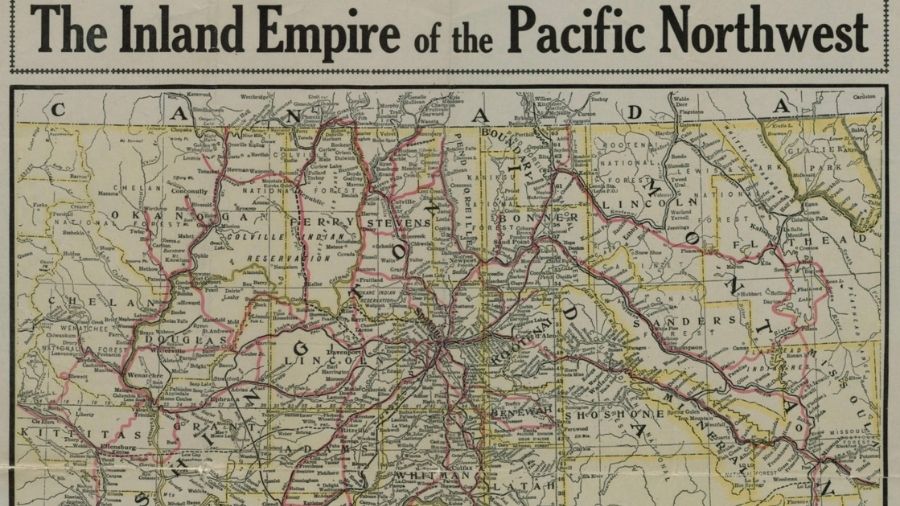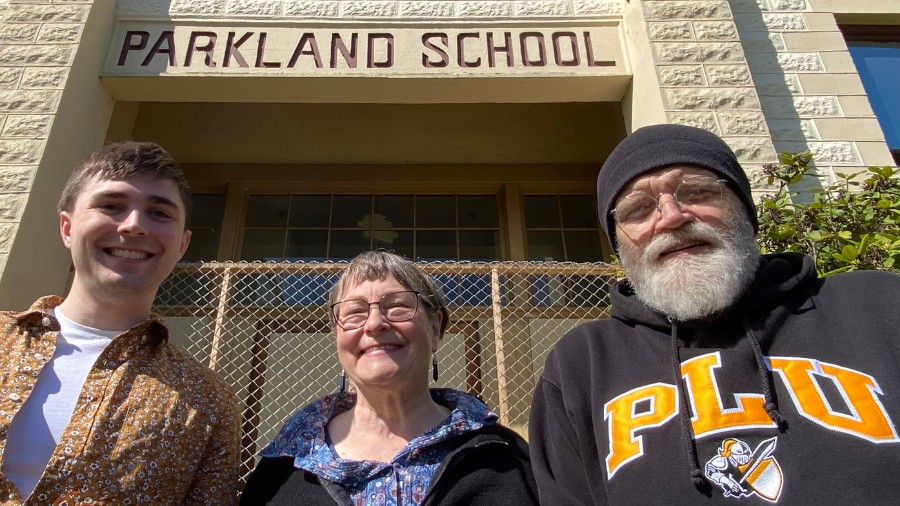All Over The Map: Who named the ‘Inland Empire?’
Jan 7, 2022, 7:46 AM | Updated: 9:51 am
The nickname “Inland Empire” probably peaked in usage on maps and tourist literature decades ago, but it’s still something that anyone who’s lived here long enough has likely heard before to describe a geographical and economic region with Spokane at its center.
Just where, exactly, is the Inland Empire? This description of the region comes from the first volume of a four-volume history called “The Inland Empire of the Pacific Northwest,” which was written by Spokane historian George Fuller and published in 1928:
“In the basin between the Rockies and the Cascades – a region as large as France – nature framed a broad theater for human enterprise and furnished it with an abundance of resources, which for a long time stood unrecognized. Across the empty stage passed explorers and fur traders. Missionaries came and labored, with small success, to open the eyes of the Natives to the uses of soil and water and timber, as well as to teach them religion.”
In a Facebook post this week on a Spokane history page, a history graduate student at Eastern Washington University in Cheney named Jake Rehm wondered if anyone knew the origins of the phrase.
There was much speculation in comments on the post that “Inland Empire” had something to do with boosterism – that still common practice of promoting a city or region in order to attract more residents, and to improve prospects for businesses – and, in the 19th century, in particular, to fuel profits for real estate speculators.
It didn’t take long for Rehm to track down the person who is generally believed to be the originator of the phrase “Inland Empire” as a way to describe and promote parts of Washington, Idaho, and even British Columbia. Rehm found the answer on page two of Fuller’s 1928 book.
Credit, Rehm says, goes to a Massachusetts-born missionary, journalist, educator, and railroad booster named Reverend George Henry Atkinson.
“He came to Oregon in the 1840s and he was aware of the kind of the climate of Eastern Washington, Oregon, Idaho, and he described it as a ‘vast Inland Empire,’” Rehm told KIRO Radio. “And now, whether or not that was the first time that term had actually been applied to the Inland Northwest, no one knows.”
According to George Fuller’s book:
“The Reverend George H. Atkinson, who arrived in Oregon city in 1848, made several trips to the interior and secured samples of soils from the Walla Walla, Palouse, and Klickitat regions and from various parts of what is now Wasco County, Oregon. After analyzing them and comparing them with samples of soils from Europe, he declared that the interior would become a great wheat growing region and that stock raising would be gradually crowded out.”
In the mid to late 1870s, Atkinson wrote a series of pro-Northwest newspaper articles for The Oregonian and the Portland Bee. Newspapers in Washington Territory reprinted, excerpted, or paraphrased many of Atkinson’s articles, and they were also compiled and issued as a pamphlet in 1878. The publication was sponsored by the Northern Pacific Railroad and called “The Northwest Coast.” It’s unclear if Atkinson directly profited in any way from his work on behalf of the railroad, and it’s also unclear exactly where the phrase “vast Inland Empire” first appears in print in Atkinson’s work – if it does at all.
The 1870s was the era when boosters in the Pacific Northwest were trying to generate interest in getting the northernmost of the government-surveyed transcontinental railroad routes built. Atkinson’s booster activities weren’t limited to only writing; a decade earlier – in 1868 – he traveled east and gave a talk to the Chamber of Commerce of the State of New York, called “Possession, Settlement, Climate and Resources of Oregon and the Northwest Coast including some remarks upon Alaska.”
The Reverend Atkinson appears to have really gotten around, especially for the 19th century, and he was a busy guy at home, too. His day job was serving as a preacher in Oregon City, and he’s also considered the father of Oregon’s public schools.
David Nicandri is an author and is the retired former director of the Washington State Historical Society. He says Atkinson kept “extensive meteorological records” and “became, if you will, the Cliff Mass of his generation.”
“The NPRR [Northern Pacific Railroad] liked him because he fell into the ‘rain follows the plow’ school of agrarianship,” Nicandri wrote in an email. “With his help, they could hope to sell off that vast tract of farmland they owned along their line. That is, ‘If you plow the Palouse, the requisite rain will follow,’ [and] ‘Don’t worry; be happy.’”
“[It] didn’t quite work out that way,” Nicandri wrote, “necessitating the Columbia Basin Project” to irrigate all that new farmland.
In 1878, a newspaper called The Inland Empire was founded in The Dalles, Oregon, and this seems to be the time when the term really began to catch on. Atkinson died in Portland in 1889 when he was almost 70; the transcontinental railroad had reached Oregon in 1883.
The Inland Northwest – as the region is also sometimes called – does not have a monopoly on “Inland Empire.” There’s part of California east of Los Angeles also known as the Inland Empire, and it might have been named a bit earlier, perhaps as early as the 1860s (there’s even a lifestyle magazine published in that area called “Inland Empire”). Somewhat surprisingly, if old tourist decals are to be believed, Illinois has been known in the past as the “Inland Empire State.”
Lastly, David Lynch – of Northwest noir “Twin Peaks” fame – made a film in 2006 called “Inland Empire” that has no relation to anything local, but for which there is an interesting name-origin anecdote.
It’s a shame that Lynch’s film doesn’t have a connection to the Northwest. Not to be greedy – what with all the economic development generated by the coffee and cherry pie at Twede’s Café in North Bend – but those anthropomorphic rabbits in “Inland Empire” seem like they’d be right at home in the Evergreen State, and surely some modern local booster would find a way to make a profit.
You can hear Feliks every Wednesday and Friday morning on Seattle’s Morning News, read more from him here, and subscribe to The Resident Historian Podcast here. If you have a story idea, please email Feliks here.

















